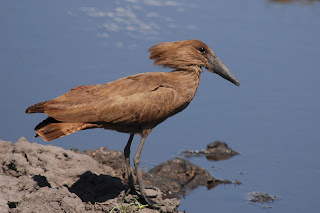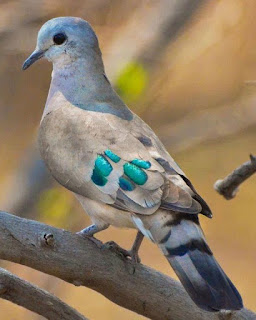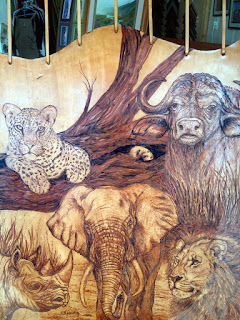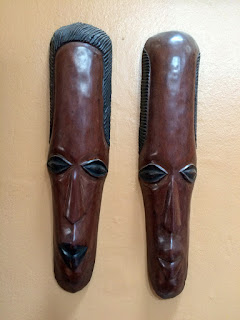Many crucial historical events with regard to the anti-apartheid struggle happened in this province. Johannesburg is now home to the Apartheid Museum and the Constitutional Court (South Africa’s highest court). The province is also a huge center of learning in South Africa with a combined presence of fifteen institutions of higher learning. However, as promising as all the cultural attractions were, our itinerary steered us away from the urban areas toward the neighboring Mpumalanga Province and the bucolic farming town of Wakkerstroom (billed as a birder’s paradise), a solid three hour drive away.
 |
| Johannesburg to Wakkerstroom |
 |
| African Crowned Crane |
 |
| Wakkerstroom Country Inn |
 |
| NGK Church and fallen Wakkerstroom Commandos memorial |
 |
| main street Wakkerstroom |
Inside the inn were hundreds of of examples of Zulu weaving and bead work on display. Most of the weaving examples were that of “imbenge”, a shallow saucer-shaped bowl woven using Ilala palm and grass fibers. Imbenge are used as platters for serving dried foodstuffs, and, used upside down, serve as a lid for pots. Collected Ilala palm fronds are pulled into strips, then hung to dry. Zulu women traditionally do the weaving. Basket colors come from extracting natural dyes by boiling indigenous flora (leaves, berries, and bark). Different patterns woven into the baskets carry different cultural meanings. Intricate triangles, diamonds, zig-zags, and checkerboard motifs illustrate many domestic, social, and religious relationships.
The overly large basin-shaped baskets called “isiquabetho” are used for gathering and carrying grain. “Ukhamba”, is a rigid bulb-shaped basket, and the “isichumo”, a rigid bottle shaped basket. The Ilala palm has a waxy surface which when wet, expands and seals, allowing for liquids to be stored or carried.
Zulu men have gotten into weaving as well. Their contribution: baskets woven from wire. Initially they used discarded telephone wire which resulted in a bright kaleidoscope of color (wouldn’t Alexander Graham Bell be interested!). However, due to telephone wire scarcity, wire used today is custom manufactured in South Africa using an annealed steel core incorporating some recycled material (all lead-free).
Bead work historically incorporated beads from bones, seeds, metal, stone, ostrich eggs, seashells, and wood. Glass beads were introduced by Egyptian Phoenician traders and were highly prized. The Phoenicians' glass bead trade was soon taken over by the Arab glass bead trade, which in turn was succeeded by the Portuguese in the 15th and 16th centuries and the Dutch and English in the 17th and 18th centuries. Today, glass beads are still highly prized and are much preferred to be worn by the Zulu nation while plastic beads are now commonly used for the tourist trade and exportation.
We spent one afternoon in the company of local guide, Lucky Ndube, an expert on where to look for some of the more difficult to find lark and pipit species. With his assistance, and during our time in the area with Andrew and Lisle, we found Larks (Eastern Clapper, Rudd’s, Pink-billed, Rufous-naped, Eastern Long-billed), Cisticolas (Cloud, Rock-loving, Pale-crowned, Wing-snapping), Drakensberg Prinia, and Pipits (Long-billed, Yellow-breasted).
A few stops at the nearby Utaga Bridge on the outskirts of town where it crossed a section of wetland added Intermediate Egret, Squacco Heron, African Rail, Black Crake, Southern Bald Ibis, African Snipe, Wood Sandpiper, Lanner’s Falcon, Yellow-crowned Bishop, African Reed-Warbler, and African Yellow-Warbler.
 |
| Fickland Pan |
 |
| Wahlberg's Honeyguide |
Sadly, it was during our afternoon spent with Lucky that we came across a recent traffic accident. As our vans approached a small village (a small cluster of huts) a blanket lay in the road which we first mistook to have been livestock but in fact, beneath the blanket lay the body of a young boy who had been struck by a passing motorist. Apparently the lad, excited to be dropped off in his small village, had darted out in front of the school van just as another vehicle was overtaking it. Even on such remote dirt roads, one has to be ever vigilant of one’s surroundings.
Late that afternoon, with storm clouds threatening, we found a Mountain Wheater. Later on along Hammersfork Road, with darkness approaching, we observed a Cape Eagle Owl hunting from atop large rocks strewn along a river bed.
 |
| Cape Eagle-Owl |
After two and a half days we missed finding the endemic Botha’s Lark (but not without a whole lot of effort!). We had, however, been fortunate to find the rest of the endemics Wakkerstroom had to offer. Time to move on.
 |
| Wakkerstroom to Lower Sabie Rest Camp |
South Africa’s first national park (1926), and covering over 7,500 square miles, Kruger is one of Africa’s largest game reserves. It measures 220 miles long (north-south) by 40 miles wide (east-west). It’s bordered by Zimbabwe at the north end and Mozambique on the east side. The Limpopo River to the north and the Crocodile River act as natural borders. Additionally, the Sabie, Olifants, Letaba, and Luvuvhu rivers run through the park.
 |
| Kruger National Park location and map |
Park flora life is divided into four main sections. 1) Thorns trees and red bush-willow, 2) knob-thorn and marula veld, 3) red bush-willow and mopane veld, and 4) shrub mopane veld.
As we were on a birding tour we had our sights set on seeing the park’s “Big Six”: Lappet-faced Vulture, Southern Ground Hornbill, Martial Eagle, Saddled-billed Stork, Pel’s Fishing Owl, and Kori Bustard. Well, make it five. We’d already seen Kori Bustard (but wouldn’t mind more looks). Seeing a Pel’s was a crap shoot. Nocturnal hunters, they are rarely seen. But in Kruger it wasn’t just the birds we sought as it would be impossible to ignore the elephant in the room. Or rather, on the road. Literally. Kruger has the “Big Five” animals (African Elephant, Cape Buffalo, White Rhinoceros, African Lion, and Leopard). We were determined to see them all.
 |
| Crocodile Bridge, Saddle-billed Stork |
Entering parks in Africa tended to be a time consuming and bureaucratic process. In part because poaching is still such a huge problem. In the case of sightings of white rhinos, for example, keeping sightings a secret extended to guests not being able to relay to other guests (outside their respective tour group) any white rhino sightings. The fear was that a “guest” just might be a spotter for poachers.
 |
| African Elephant |
 |
| elephant temper tantrum left uprooted, uneaten, and wasted vegetation |
Elephants don’t digest much more than 40% of the food they take in. Much of it passes straight through. As a result, driving over elephant dung is potentially dangerous. Many plants they eat have large thorns - long sharp thorns - that end up being excreted whole and hidden in elephant dung. Thorns that can puncture tires. We didn’t want to get out of a vehicle to fix a flat tire in a food chain where we were definitely not at the top. Avoid the dung.
 |
| the king rests anywhere he wants |
 |
| possible future nominee for a Darwin Award |
 |
| Lisle's pic of the stressed Crested Porcupine |
 |
| short version: if eaten while eating, don't blame us |
 |
| Southern Yellow-billed Hornbill |
 |
| Lower Sabie Rest Camp |
Lower Sabie was also where we experienced our second nighttime safari drive. As in Karoo, we split the group to accommodate getting the entire group on a drive. With only one tour per evening, Harold, Carol and Tom, as we had in Karoo, volunteered to go on the first night.
All our meal opportunities while in the park were found only in the rest camps and at a handful of cooking equipped park picnic sites, all handled by contracted vendors. There were no opportunities for fast food outside these sites (except of course for the naturally occurring ‘fast food’ impalas...and the lions weren't sharing). Situated on a large deck overlooking the Sabie River we ordered our food from the Mugg and Bean restaurant. Interestingly, the seed for establishing Mugg and Bean in Africa began with a couple from Cape Town visiting a south side Chicago coffee shop. Enamored, they brought the concept back and opened the first Mugg and Bean in Cape Town in 1996. Their franchises quickly spread across Africa and beyond. We recommend the upside down marshmallow frozen hot chocolate.
 |
| Zebras, White Rhinos by day; lion by night |
Because of much longer wait times, the three of us signed up for the night safari ran out of time to finish our meals and had to skip completing our checklists. Rushing back to our bungalows to collect extra clothing and lights, we barely made it back in time to board the open-air vehicle. Carol wound up riding up front with the driver while Harold and Tom squeezed into the last open bench seat.
The atmosphere aboard the vehicle was 180 degrees from our previous night safari experience at Karoo. The driver sat well out of sight from the main seating area. There was no park ranger to provide commentary or exert some semblance of order. Participants had simply been handed four powerful searchlights and instructed to “look for eye shine”. If anything of interest was found, to shout for the driver to stop. Chaos reigned. Those with searchlights waved them willy-nilly, severely limiting night vision. A loud and boisterous group behind us clearly had been drinking. When anyone thought they saw something and shouted to stop, the driver often didn’t hear about it until it was too late. As a result little was seen. When a pair of lions was found walking next to the road, a mad rush to stand and take pictures (with their cell phones outstretched over the side) made it impossible for many aboard to get good looks. Those armed with spotlights failed to comprehend respecting the animals' night vision by continually shining lights in the eyes of the animals. All in all, a completely unprofessional carnival ride tour, an utter waste of time and money. Had there been more to see (and who knows that there wasn’t) and a park ranger to oversee the tour, well, it might have turned out better. We arrived back at the camp cold, tired, thoroughly disgusted and in bad humor. It was almost midnight by the time we fell into bed.
The next morning we informed our group of the previous night's misadventure. Josh’s group would be on the next night’s tour along with the rest of ours, and thus forewarned, Lisle, Josh, and Andrew made sure they took charge of the spotlights. Between the three experienced guides, it made for a much more controlled tour. They also had the good fortune of coming across a freshly killed Cape buffalo. While lions fed, other wildlife (hyena, jackal) jockeyed for a share of the spoils. They also observed a few Genet species (small cats), and a Verreaux’s Eagle-Owl. What a difference a night makes.
 |
| Southern Cordonbleu |
 |
| Hammerkop |
 |
| Emerald-spotted Dove |
 |
| Red-billed Oxpecker |
 |
| Leopard |
 |
| Giraffe, Cape Buffalo |
 |
| Impala |
 |
| Greater Kudo |
 |
| south-central Kruger NP |
 |
| Secretary Bird |
 |
| Marabou Stork |
Our digs at Satara were similar to Lower Sabie although the layout was a bit different. Several circles of bungalows arranged around circular open spaces. While settling in, we were distracted by a commotion on our patio (where our outdoor kitchen was located). A troop of marauding Banded Mongoose were making the rounds. That night we learned from Lisle and Andrew that a Honey Badger (we had gotten distant looks at one) was also scrounging the same containers causing Lisle and Andrew to race about in their skivvies trying to get photos. Honey Badgers are rarely seen so having one so close was a coup. We imagined the sight of professional guides running about in the dark in their underwear is also pretty rare. At least that's what they told us.
 |
| African Wild Cat |
 |
| Eurasian Hoopoe |
 |
| Green Wood-Hoopoe |
Our marching orders for the next day, the last day of the main tour, had us exiting Kruger at the Orpen Gate then taking a circuitous route back to Johannesburg to drop off Melissa and Jose, who, due to work schedules, would not be participating in the trip extension. A few birding breaks along the way netted us Common Quail, Black-breasted Snake-Eagle, Fan-tailed Grassbird, Wailing Cisicola and just before arriving back at the Africa Journey Inn, a Square-tailed Nightjar.
 |
| Satara Rest Camp to Johanessburg |
 |
| Greater Blue-eared Glossy-Starling |
 |
| Red-headed Weaver |
 |
| Water Thicknee |
 |
| Red-chested Wryneck |
 |
| Chinstrap Batis |
 |
| Pearl-spotted Owlet |
 |
| Squacco Heron |


































































No comments:
Post a Comment